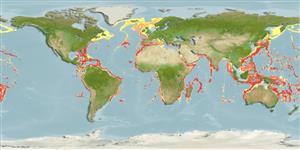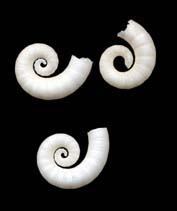Spirula spirula (Linnaeus, 1758)
Ram's horn squid| Native range | All suitable habitat | Point map | Year 2050 |

|
| This map was computer-generated and has not yet been reviewed. |
| Spirula spirula AquaMaps Data sources: GBIF OBIS |
Classification / Names Common names | Synonyms | CoL | ITIS | WoRMS
Cephalopoda | Spirulida | Spirulidae
Environment: milieu / climate zone / depth range / distribution range Ecology
Pelagic; depth range 100 - 1750 m (Ref. 1695). Tropical; ? - 10°C (Ref. 1695); 69°N - 32°S, 89°W - 160°W
Distribution Countries | FAO areas | Ecosystems | Occurrences | Introductions
Circumglobal in tropical and subtropical oceanic waters. Tropical to polar.
Length at first maturity / Size / Weight / Age
Maturity: Lm ?, range 30 - ? cm Max length : 4.5 cm ML male/unsexed; (Ref. 1695)
Minimum depth from Ref. 106682. Rarely exceeds 4.5 cm ML (Ref. 1695). Migrates from 550 to 1000 meters during the day, and 100 to 300 meters at night (Ref. 106682). Young is captured at depths 1,000 to 1,750 m, which suggests that females lay eggs on bottom of continental slopes (Ref. 1695). Dead shells washed up on the beaches often in large numbers (Ref. 88739).
Life cycle and mating behavior Maturity | Reproduction | Spawning | Eggs | Fecundity | Larvae
Members of the class Cephalopoda are gonochoric. Male and female adults usually die shortly after spawning and brooding, respectively. Mating behavior: Males perform various displays to attract potential females for copulation. During copulation, male grasp the female and inserts the hectocotylus into the female's mantle cavity where fertilization usually occurs. Life cycle: Embryos hatch into planktonic stage and live for some time before they grow larger and take up a benthic existence as adults.
Main reference
References | Coordinator | Collaborators
Jereb, P. and C.F.E. Roper (eds.). 2005. (Ref. 1695)
IUCN Red List Status (Ref. 130435)
Least Concern (LC) ; Date assessed: 29 March 2009
CITES status (Ref. 108899)
Not Evaluated
CMS (Ref. 116361)
Not Evaluated
Threat to humans
Human uses
| FishSource |
Tools
More information
Internet sources
BHL | BOLD Systems | CISTI | DiscoverLife | FAO(Publication : search) | Fishipedia | GenBank (genome, nucleotide) | GloBI | Gomexsi | Google Books | Google Scholar | Google | PubMed | Tree of Life | Wikipedia (Go, Search) | Zoological Record
Estimates based on models
Preferred temperature
(Ref. 115969): 4.7 - 11.6, mean 7.1 (based on 951 cells).
Price category
(Ref. 80766):
Unknown.



